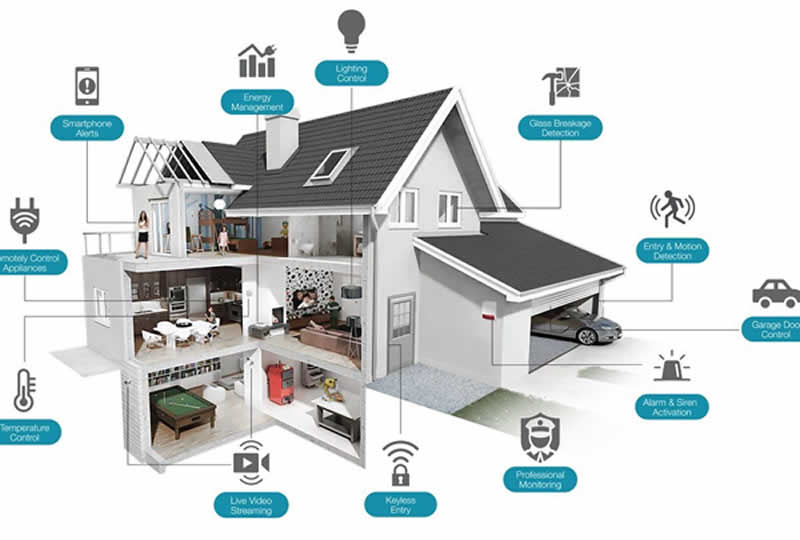Soon, a small wrist device will verify your identity by syncing with your unique heartbeat. Imagine your home adjusting its lighting, temperature, and music to your preferences and pre-set profiles. This futuristic concept is not far-fetched. In fact, companies are investing millions into creating technologies that seamlessly merge our digital and physical worlds. New technologies will be instrumental in leveraging data to analyze and enhance building performance and resource utilization.
By harnessing grid data and energy use information, AI will optimize resource consumption, increase comfort, and improve cost-effectiveness. This technology, found in popular devices, allows for seamless control and convenience. Not only can advanced home security systems be controlled with voice commands, but the latest advancements in home automation systems also offer hands-free channel surfing and control of Bluetooth speakers. However, it should be noted that the emergence of voice assistant features also raises security concerns, as some researchers have successfully hacked smart devices using inaudible techniques.

Home Security
Thanks to recognition, AI-powered machines can easily identify objects or faces. In addition, users can utilize special tools for fixing the issue with slow Internet. If a connection is unreliable, people can use a VPN and Internet speed will improve in no time. Facial recognition technology can analyze facial landmarks and compare them with stored data. Additionally, these machines can send notifications to homeowners' smartphones about visitors at the front door. Advanced home security cameras can even recognize the faces of family members.
Next-generation home security systems employ AI logic to actively monitor and analyze for potential security threats, ensuring the house is well-protected. Smart cameras are capable of recording high-definition videos and automatically storing them in the cloud for future reference. By utilizing connected apps, homeowners can easily monitor and safeguard their houses against threats.
AI is also utilized in smart locks, which can be conveniently controlled through smartphones thanks to a secure connection established through VeePN. Biometric door locks can be easily integrated into popular smart home ecosystems. With the power of AI, homeowners can have peace of mind knowing that their homes are equipped with advanced security measures to keep them safe and protected.
There are advanced smoke alarms that you can install during home renovation that offer a range of intelligent features. These sophisticated smoke alarms can alert the user through various means, including smartphone notifications for low battery and precise detection and location of fire or smoke outbreaks. Additionally, these alarms can be easily switched to silent mode when needed. A VPN extension enables you to adjust their settings. With the help of voice alerts, these smart smoke detectors can provide timely notifications at the first sign of smoke, ensuring prompt response during emergency situations.
Power Consumption
People spent $127 billion on smart home devices. By integrating automatic energy storage systems with distributed energy sources, it enables the efficient storage and utilization of electricity. An example of this is the Tesla Powerwall, which stores electricity for use during the night or in the event of a power outage. As a result, smart homes are able to reduce their reliance on the electricity grid.
By analyzing the overall demand for electricity and considering the variable tariff structure of the utility, it can suggest the most cost-effective times for EV owners to charge their vehicles. This technology also aids utility companies in managing energy demand and maintaining grid stability.
Future Developments

The number of "smart" residential households is on the rise, as there are 60.4 million homes with smart devices in the U.S. at the moment. However, with this growth comes an increase in security threats. Wirelessly connected devices are particularly vulnerable to cyber-attacks. A single leak had a significant impact, affecting nearly 600,000 devices worldwide and causing a redirection of web traffic and service disruptions for popular websites. Had these companies used VeePN, they could have prevented this data breach.
Companies are now exploring the realm of integrating artificial intelligence with emotions. LG has given their Clio robot a cheerful personality, while Sony is infusing unique emotions into their next-generation Aibo Robotic dogs. Personal assistants and avatars can now express a range of 12 emotions, including pleasure, frustration, pain, and satisfaction. This cutting-edge Emotion Processing unit even allows for control over facial expressions and body language on both robots and avatars displayed on desktop screens.
Google Assistant understands and speaks multiple languages. This breakthrough has proved particularly useful for bilingual households, as the Assistant can now communicate with all family members in their preferred language. With advancements in speech recognition, the role of AI becomes even more important as one can seamlessly switch between two languages while interacting with the Assistant.
There were cases when devices were unnecessarily enabled, forcing human intervention to rectify errors or make decisions. In order for artificial intelligence to become ever-present, current-generation systems must operate autonomously without the need for human involvement.
